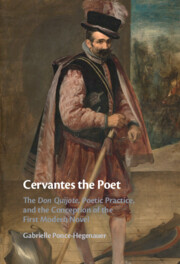 Cervantes the Poet
Cervantes the Poet Book contents
- Cervantes the Poet
- Cervantes the Poet
- Copyright page
- Dedication
- Contents
- Figures
- Acknowledgments
- Note on Abbreviations, Translations, and Terms
- Introduction The Unknown History of the Conception of the Don Quijote
- Chapter 1 Mimesis in the Court of Gentlewomen: The Pastoral Fabric of Everyday Life
- Chapter 2 Exalted Apostrophes: Cervantes in the Court of Isabel de Valois
- Chapter 3 Figura of the Poet: Pastoral Petrarchism as the Practice of Ingenious Gentlemen
- Chapter 4 The Form of Beauty: Lyric Lovers in the Mediterranean World
- Chapter 5 The Poet as Literary Character: Eclogues and Encomia in Madrid
- Chapter 6 The Literary Character as Poet: Lyric Subjectivity, Chronotopic Dynamism, and Plot in the Galatea
- Coda Alonso Quijano’s Lyric Subjectivity:
- Index
Chapter 1 - Mimesis in the Court of Gentlewomen: The Pastoral Fabric of Everyday Life
Published online by Cambridge University Press: 11 May 2023
- Cervantes the Poet
- Cervantes the Poet
- Copyright page
- Dedication
- Contents
- Figures
- Acknowledgments
- Note on Abbreviations, Translations, and Terms
- Introduction The Unknown History of the Conception of the Don Quijote
- Chapter 1 Mimesis in the Court of Gentlewomen: The Pastoral Fabric of Everyday Life
- Chapter 2 Exalted Apostrophes: Cervantes in the Court of Isabel de Valois
- Chapter 3 Figura of the Poet: Pastoral Petrarchism as the Practice of Ingenious Gentlemen
- Chapter 4 The Form of Beauty: Lyric Lovers in the Mediterranean World
- Chapter 5 The Poet as Literary Character: Eclogues and Encomia in Madrid
- Chapter 6 The Literary Character as Poet: Lyric Subjectivity, Chronotopic Dynamism, and Plot in the Galatea
- Coda Alonso Quijano’s Lyric Subjectivity:
- Index
Summary
Chapter 1 recovers the pastoral precedents for the culture that directly precipitated Cervantes’ first poems within the court of Isabel de Valois (Queen of Spain, 1560–1568), in which literary art forms and forms of cultural practice became intertwined in complex mimetic processes. From Theocritus, Vergil, Horace, Ovid, Petrarch, Boccaccio, Poliziano, and Sannazaro to Garcilaso de la Vega, Juan Boscán, and Jorge de Montemayor, the retreat of the pastoral was understood to be a device employed to encode and allegorize the private life and lived experience of the court which made poiesis possible. Drawing on archival records (relaciones) of life in the court, the diary kept by one of the queen’s ladies-in-waiting, and histories of Isabel’s reign, Chapter 1 explores the frequent and often improvisational imitation of various literary genres, including the romance of chivalry, by members of the court caught up in erotic entanglements which became the content of pastoral fiction. At the confluence of literary allegory and contemporary history, through the exchange of motes in the terrero, the palace became pastoral.
Keywords
- Type
- Chapter
- Information
- Cervantes the PoetThe <i>Don Quijote</i>, Poetic Practice, and the Conception of the First Modern Novel, pp. 22 - 49Publisher: Cambridge University PressPrint publication year: 2023
